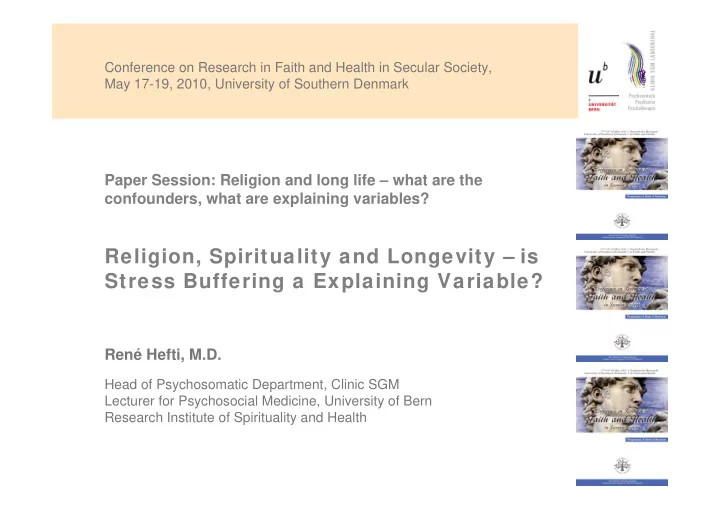

Conference on Research in Faith and Health in Secular Society, May 17-19, 2010, University of Southern Denmark Paper Session: Religion and long life – what are the confounders, what are explaining variables? Religion, Spirituality and Longevity – is Stress Buffering a Explaining Variable? René Hefti, M.D. Head of Psychosomatic Department, Clinic SGM Lecturer for Psychosocial Medicine, University of Bern Research Institute of Spirituality and Health
Personal Background - Medical School at the University of Zurich - Clinical training in internal medicine and noninvasive cardiology - Interest in psychosomatic medicine and religion/spirituality & health - Head of psychosomatic department and lecturer at the University of Bern - Head of the Research Institute for Spirituality and Health (RISH)
Psychosomatic Department
Introduction - There is growing evidence for a link between religion/ spirituality and health (Koenig et al.) - There is also evidence that religious involvement is associated with lower mortality (Chida et al.)
salutogenetic aspect of religiosity/spirituality
not a clear association/influence of r/s
20% risk reduction in coronary death
Possible Mechanims • Life stile factors = healthier life stile • Improved social support, better networks • Improved coping behavior, religious coping • More positive emotions, optimism • better mental health • less psychological distress • Stress buffering effect of R/S ?
Cardiovascular Reactivity - Important concept in psychosomatic medicine - Cardiovascular response to mental (Stroop), social (TSST) and physical challenges - Typical measures: - Heart Rate (HR) and Heart Rate Variability (HRV) - Blood Pressure (BP), Blood Pressure Variability (BPV) - Cardiac output (CO) and pre-ejection period (PEP) - Psychophysiological risk factor for cardio- vascular disease (Hypertension, CAD) - Individual differences in cv reactivity are determined by complex mechanisms (Lovallo)
Cardiovascular Reactivity Religiositiy Three level model - The fronto-limbic system (cognitions and emotions) - Hypothalamus and brainstem (regulatory centers, configure outputs to the body) - Peripheral Organs (different response characteristic) - Lovallo 2005
Masters et al. 2004 CVR and Religiosity
CV REACTIVITY PROJECT Clinic SGM Clinic SGM & RISH & RISH Universitiy of Universitiy of Bern Bern
CV REACTIVITY PROJECT • Master thesis of Sibylle Probst & Robert Pfandl, psychology students at the University of Bern • 40 patients with mild to severe depression • Assessment of medical history and medications (cardiovascular. psychiatric) • Assessment of BDI, SCL, S-R-T (centrality, emotions towards God) and RCOPE • Mental stress testing = Color-Stroop
Structure of Religiosity Test
Stress testing / protocol We assessed BP (syst/diast), HR and HRV according the following protocol Stroop Stroop info baseline recov 1 recov 2 test 1 test 2 Verlauf HF 88.00 86.00 84.00 82.00 80.00 78.00 76.00 74.00 72.00 70.00 HF BL HF Stroop1 HF Rec1 HF Stroop2 HF Rec2
Sample characteristics
Sample Characteristics
Physiological Parameters
Physiological Parameters
Physiological Parameters
Course of HR/HRV during Stroop Verlauf HF 88.00 86.00 84.00 82.00 80.00 78.00 76.00 74.00 72.00 70.00 HF BL HF Stroop1 HF Rec1 HF Stroop2 HF Rec2 Verlauf HRV 45.00 40.00 35.00 30.00 25.00 20.00 15.00 10.00 5.00 0.00 HRV BL HRV Stroop1 HRV Rec1 HRV Stroop2 HRV Rec2
BP-Reactivity during Stroop Verlauf SBD 135.00 130.00 125.00 120.00 115.00 110.00 105.00 100.00 SBD BL SBD Stroop1 SBD Rec1 SBD Stroop2 SBD Rec2 Verlauf DBD 88.00 86.00 84.00 82.00 80.00 78.00 76.00 74.00 72.00 70.00 DBD BL DBD Stroop1 DBD Rec1 DBD Stroop2 DBD Rec2
Linear Regression Model b Aufgenommene/Entfernte Variablen Results: Aufgenomme Entfernte Modell ne Variablen Variablen Methode - Religiosity (centrality) 1 sex Geschlecht, . Eingeben a explained 20% of the age Alter 2 BDIeS1 a . Eingeben variance of BP-reactivity BDI-Wert 3 RSTeS10 a . Eingeben Zentralität - Age, sex and BDI a. Alle gewünschten Variablen wurden aufgenommen. explained less than 10% b. Abhängige Variable: DSt1SBD Reaktivität SBD Stroop1-BL Modellzusammenfassung Änderungsstatistiken Standardf Änderung in Korrigiertes ehler des Änderung in Signifikanz Modell R R-Quadrat R-Quadrat Schätzers R-Quadrat Änderung in F df1 df2 von F 1 .282 a .079 .025 11.01234 .079 1.466 2 34 .245 .282 b 2 .080 -.004 11.17704 .000 .005 1 33 .942 .503 c 3 .253 .159 10.22686 .173 7.417 1 32 .010 a. Einflußvariablen : (Konstante), sex Geschlecht, age Alter b. Einflußvariablen : (Konstante), sex Geschlecht, age Alter, BDIeS1 BDI-Wert c. Einflußvariablen : (Konstante), sex Geschlecht, age Alter, BDIeS1 BDI-Wert, RSTeS10 Zentralität
Discussion /Conclusion • There is evidence for a stress buffering effect of religiosity on cardiovascular reactivity in depressed patients • Clearly for BP-reactivity • Possibly also for HR/HRV • How does medication influence this association? • Further analyses and testing of the hypotheses is needed
Recommend
More recommend